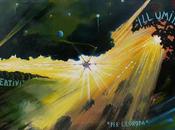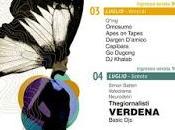
The Homecoming of Beorhtnoth di J.R.R. Tolkienin Essays and StudiesA cura di Geoffrey Bullough1° edizione 1953John Murray (Publishers) Ltd., LondraRilegato con sovraccoperta

NoteSi tratta del sesto volume della nuova serie di «Essays and Studies» curata da Geoffrey Bullough per la English Association. All’interno l’Ofermode Beorhtnoth's Death, due saggi pubblicati con il poema The Homecoming of Beorhtnoth, Beorhthelm's Son da pagina 1 a pagina 18.Tolkien, già nel 1929, pubblica Ancrene Wisse and Hali Meiðhad nel volume «Essays and Studies by members of the English Association», Oxford, volume 14, pp. 104–126. Un saggio dove il professor Tolkien sostiene che le lingue utilizzate nelle versioni originali dei testi Medio inglesi Wisse e Hali Meiðhad sono le stesse - una lingua che lui ha indicato come “language (AB)”.
In Notes on Contributorssi legge:
J.R.R. Tolkien, born in 1892, is Merton Professor of English Language and Literature at Oxford. Well known for his edition of Sir Gawain and the Green Knight (with the late E.V. Gordon), for his work on Beowulf, and for his verse translation of The Pearl. Professor Tolkien’s fairy-story, The Hobbit, is a great favourite.

Contents
The Homecoming of Beorhtnoth Beorhthelm's Sonby J.R.R. Tolkien;
Family Honour in the Plays of Shakespeare's Predecessors and Contemporaries
by Edward M. Wilson
Some Sixteenth and Seventeenth Century Writers on the Plagueby Herbert G. Wright
John Wilmot, Earl of Rochester, and the "Right Veine of Satireby Vivian de S. Pinto
The Augustan Pantheon: Mythology and Personification in Eighteenth Century Poetryby Rachel Trickett
The Integrity of Biographia Literariaby George Whalley
Language, Style, and the Anglo-Welsh
by Gwyn Jones

Il testoThe Homecoming of Beorhtnoth Beorhthelm's Son (trad. it. Il ritorno di Beorhtnoth figlio di Beorhthelm) è un‘opera pubblicata da Tolkien per la prima volta nel 1953 nella rivista «Essays and Studies».Si tratta di un romanzo storico ambientato nelle tarde ore del giorno successivo alla Battaglia di Maldon, lo scontro tra inglesi e vichinghi avvenuto il 10 agosto 991 nei pressi di Maldon (Essex, Inghilterra) e che ispirò il celebre poema medievale omonimo (è sopravvissuto un frammento di 325 righe, scritto in anglosassone). L'opera si propone come un epilogo alla Battaglia di Maldon: Torhthelm e Tìdwald, due messi dell'abate di Ely (inviati per recuperare il cadavere del conte inglese Beorhtnoth - o Byrhtnoth -), dialogano mentre esaminano le salme dei caduti al lume di una lanterna. Un lavoro accompagnato da due saggi e che quindi si presenta come:
The Death of Beorhtnoth (La morte di Beorhtnoth) - un saggio introduttivo riguardante la battaglia e il frammento in Old English che ha ispirato Tolkien;The Homecoming of Beorhtnoth Beorhthelm's Son (Il ritorno di Beorhtnoth figlio di Beorhthelm) - il testo vero e proprio.Ofermod - un saggio nel quale Tolkien discute sul significato della parola Old English ofermod, “overconfidence, foolhardiness” (eccessiva sicurezza o presunzione e temerarietà o sconsideratezza).
La posizione dei criticiImportanti critici letterari concordano sul fatto che "Homecoming" è in realtà una critica pungente di Tolkien all'ethos eroico del nord. Ad esempio, utilizzando le bozze originali di Tolkien di "Homecoming", Thomas Honegger rivela che Tolkien era in particolar modo interessato a posizionare l’orgoglio di Beorhtnoth in una luce totalmente negativa [Honegger, Thomas (2007). "The Homecoming of Beorhtnoth: Philology and the Literary Muse". Tolkien Studies 4.1: 189–99]. George Clark sottolinea anche che la rielaborazione di Tolkien della Battaglia di Maldon, nello specifico "punisce” Beorhtnoth per il suo orgoglio e in generale critica gli ideali eroici anglosassoni di perseguire fama e ricchezza materiale [Clark, George (2000). George Clark and Daniel Timmons, ed. J. R. R. Tolkien and His Literary Resonances: Views of Middle-earth. Westport, CT: Greenwood Press. pp. 39–51]. Sulle posizioni simili anche Tom Shippey che sostiene che la condanna di Tolkien inflitta a Beorhtnoth in "Homecoming" è "un atto di parricidio" contro i suoi vecchi antenati letterari inglesi [Shippey, T.A. (2007). Roots and Branches: Selected Papers on Tolkien. Zurich and Berne: Walking Tree Publishers. pp. 323–39].
Le principali edizioni
The Homecoming of Beorhtnoth Beorhthelm's Son è stato pubblicato negli Stati Unit in Tolkien Reader (1966) e in Inghilterra in Tree and Leaf Smith of Wootton Major The Homecoming of Beorhtnoth (1975) e in Poems and Stories (1980). Mentre in Italia in Albero e Foglia (1976) e Il ritorno di Beorhtnoth figlio di Beorhthelm (2011).







